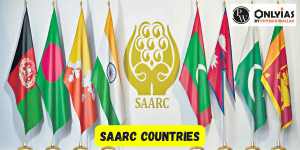
The South Asian Association for Regional Cooperation, SAARC Countries stands as a testament to the shared aspirations and collaborative efforts of eight South Asian countries. These nations, with their diverse cultures and histories, have come together to forge a platform for regional cooperation, with the aim of addressing common challenges and pursuing collective development. The SAARC region encompasses Afghanistan, Bangladesh, Bhutan, India, Maldives, Nepal, Pakistan, and Sri Lanka. Let’s delve into the functions, objectives, map, and significance of this pivotal alliance.

SAARC’s primary function lies in promoting and facilitating cooperation among its member states. This collaboration spans various sectors, including agriculture, trade, environment, culture, health, and social issues. By engaging in open dialogue and sharing best practices, member countries strive to address mutual concerns and create a more prosperous and harmonious region. SAARC’s various mechanisms, such as ministerial meetings and working groups, play a crucial role in advancing cooperation and coordination.
The South Asian Association for Regional Cooperation (SAARC) represents an alliance of eight nations in South Asia, united by shared political and economic objectives. Founded in 1985, SAARC includes Bangladesh, Bhutan, India, the Maldives, Sri Lanka, Pakistan, Nepal, and Afghanistan, the last of which joined the fold in 2007. Rooted in the pursuit of social progress, economic growth, and cultural development, SAARC plays a pivotal role in shaping the region’s future. Let’s delve into the functions, objectives, headquarters, member countries, observer countries, and the historical importance of this regional collaboration.
SAARC serves as a platform for enhancing collaboration and cooperation among its member states. Its primary functions include facilitating dialogue, fostering trust, and addressing mutual concerns across various sectors, such as agriculture, trade, and environment. By uniting the efforts of its diverse nations, SAARC strives to improve the lives of their citizens and promote regional prosperity.
The core objectives of SAARC Countries, as outlined in its charter, are as follows:
The SAARC headquarters and secretariat are located in Kathmandu, Nepal, signifying the physical embodiment of regional cooperation. This central hub serves as a conduit for communication, coordination, and the execution of SAARC activities.
The strength of SAARC lies in its member nations, united by a shared vision for progress and development. Here is the list of SAARC member countries:
SAARC Countries: Observer Countries
In addition to its member countries, SAARC Countries engages with observer countries that contribute to its discourse and initiatives. The list of SAARC observer countries includes:
Historical Significance of SAARC Countries: Nurturing Unity
SAARC’s establishment in 1985 marked a significant milestone in fostering unity among South Asian nations. Despite challenges and differences, SAARC has played a vital role in addressing shared concerns, such as poverty, illiteracy, and socio-economic conditions. By aligning their efforts, SAARC member countries have advanced in common areas and found collective solutions to pressing issues.
The SAARC Summit stands as a pinnacle of decision-making and collaboration. Hosted every two years by member states in alphabetical order, the Summit provides a platform for leaders to discuss and outline directives for advancing regional cooperation. It underscores the importance of dialogue, trust-building, and collective action within the SAARC framework.

SAARC’s journey signifies the potential of regional collaboration to drive positive change. By uniting nations, fostering understanding, and addressing common challenges, SAARC has emerged as a beacon of hope for South Asia. As member countries continue to work together, they demonstrate the power of collective efforts in shaping a brighter future for the entire region.
SAARC was established with a clear set of objectives aimed at achieving economic and social development within the region. These objectives include:
The SAARC region spans across the South Asian continent, encompassing a diverse range of landscapes, cultures, and traditions. Stretching from Afghanistan in the west to the Maldives in the Indian Ocean, and from Bangladesh in the east to Pakistan in the west, this region covers an area of immense significance. The geographical diversity within SAARC underlines the organization’s potential to address a wide array of challenges and opportunities.
The significance of SAARC cannot be overstated. By fostering regional cooperation, the alliance plays a pivotal role in shaping the collective destiny of its member countries. Through various initiatives, SAARC has contributed to reducing poverty, improving healthcare, promoting gender equality, and fostering sustainable development. Additionally, SAARC serves as a platform for dialogue, allowing member nations to discuss pressing issues and find common ground.
Despite its immense potential, SAARC has faced challenges such as political differences and bilateral tensions among its member states. These hurdles have at times hindered the organization’s ability to fully realize its objectives. Nevertheless, SAARC remains an important vehicle for promoting regional unity, cooperation, and development.

NATO Countries 2023: List, Map, Full Form, and Member Names
States and Capitals of India 2023, List of 28 Indian States and 8 Union Territories 2023
<div class="new-fform">
</div>
